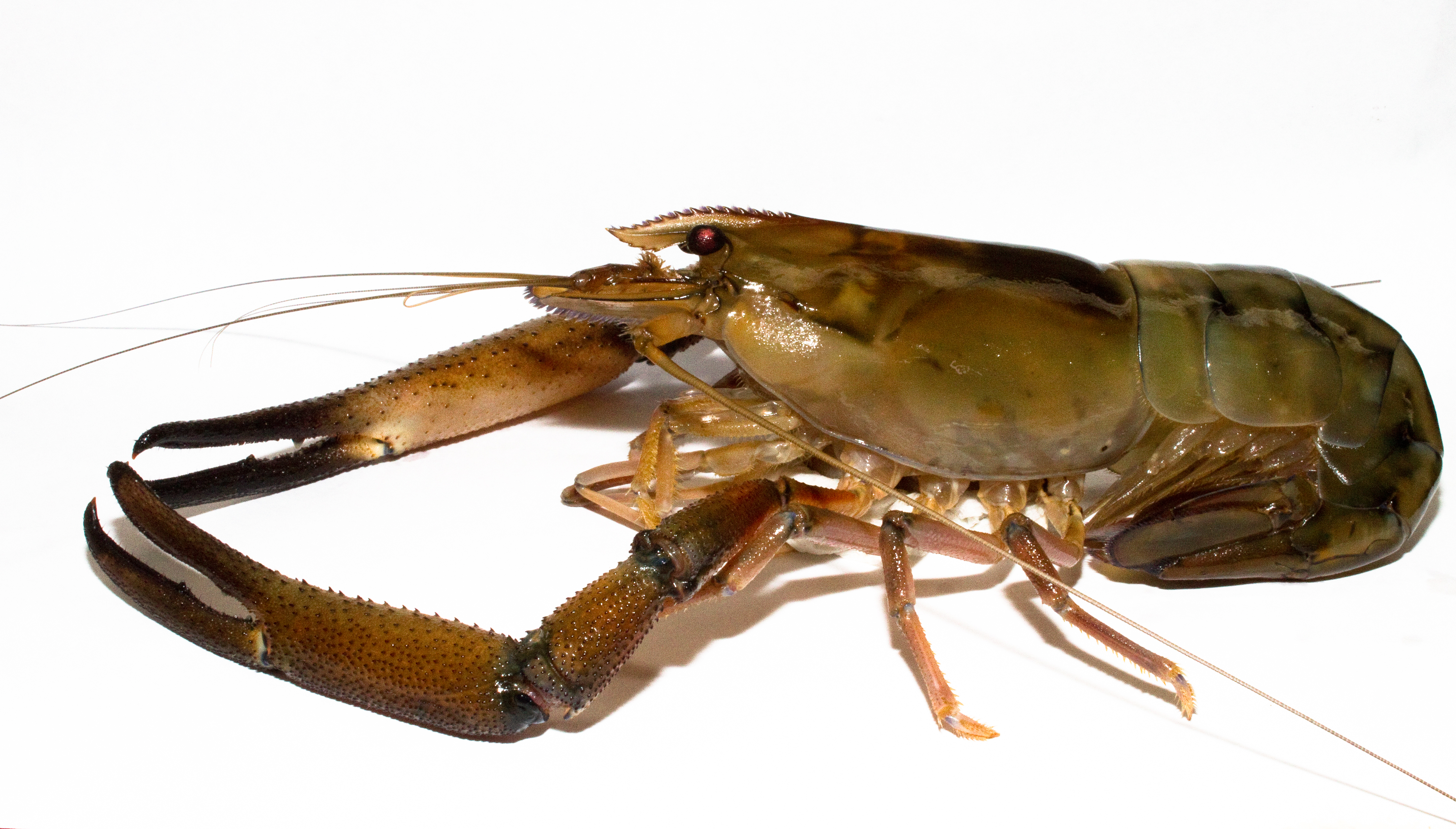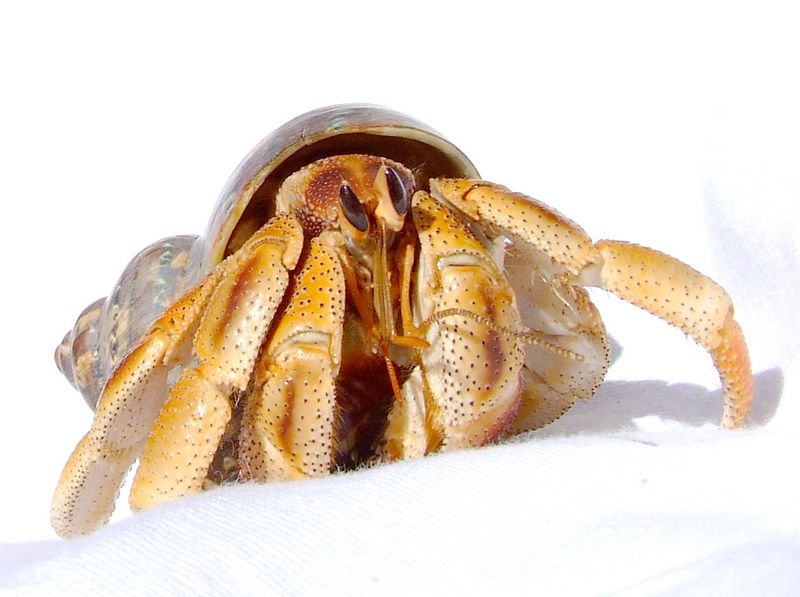|
Polychelida
Polychelida is an infraorder of decapod crustaceans. Fossil representatives are known dating from as far back as the Upper Triassic. A total of 38 extant species, all in the family Polychelidae, and 55 fossil species have been described. History Polychelida had traditionally been included in the infraorder Palinura, alongside the spiny lobsters and slipper lobsters (now in the infraorder Achelata). In 1995, Gerhard Scholtz and Stefan Richter of the carried out a phylogenetic study of the "Reptantia", and concluded that "Palinura" was paraphyletic. They therefore abandoned that taxon and introduced instead the new clade Polychelida. Classification Polychelida belongs to the group Reptantia, which consists of the walking/crawling decapods (lobsters and crabs). Polychelida is the sister clade to the infraorder Astacidea, which contains the "true" lobsters and crayfish. The cladogram below shows Polychelida's placement within the larger order Decapoda, from analysis by Wolfe '' ... [...More Info...] [...Related Items...] OR: [Wikipedia] [Google] [Baidu] |
Polychelidae
The family Polychelidae contains thirty-eight extant species of blind, benthic lobster-like crustaceans. They are found throughout the world's tropical, sub-tropical and temperate oceans, including the Mediterranean Sea and the Irish Sea. Anatomy The family Polychelidae is notable for the number of chelate (clawed) limbs, with either four or all five pairs of pereiopods bearing claws. This gives rise to the scientific names ''Polycheles'' (many-clawed) and ''Pentacheles'' (five claws). The first pair of periopods are greatly elongated, but often become broken off while specimens are being brought to the surface. The rostrum is very short or absent, and, although eyestalks are present, the eyes are absent. This family can be seen as evidence of the transition from shrimp-like animals to lobster-like animals, since they possess a number of primitive characters (plesiomorphies), such as the pointed telson, in contrast to the rounded telson in lobsters. Discovery Although apparen ... [...More Info...] [...Related Items...] OR: [Wikipedia] [Google] [Baidu] |
Stereomastis Sculpta
''Polycheles sculptus'' is a species of "strange, blind crustacean" resembling a prawn or a squat lobster. It has a cosmopolitan distribution in deep water, being found on both sides of the Atlantic Ocean, in the Mediterranean Sea, and across much of the Indo-West Pacific The Indo-Pacific is a vast biogeographic region of Earth. In a narrow sense, sometimes known as the Indo-West Pacific or Indo-Pacific Asia, it comprises the tropical waters of the Indian Ocean, the western and central Pacific Ocean, and the ..., at depths of . Gallery File:Polycheles sculptus MNHN.jpg, ''Polycheles sculptus'' on display File:Decapoda reptantia of the coasts of Ireland (1914) (20656358148).jpg, Illustration from ''Decapoda reptantia of the coasts of Ireland'' File:Stereomastis sculpta (syn. Polycheles sculptus).jpg, ''Stereomastis sculpta'' (syn. ''Polycheles sculptus'') on display (colors have faded) References Polychelida Arthropods of the Dominican Republic Crustaceans descr ... [...More Info...] [...Related Items...] OR: [Wikipedia] [Google] [Baidu] |
Tetrachelidae
''Tetrachela raiblana'' is an extinct species of polychelid crustacean from the Late Triassic. It is the only species in the family Tetrachelidae. It is distinguished from most other polychelids, including all the extant Polychelidae, by the retention of the diaeresis (divisions) of the uropod Uropods are posterior appendages found on a wide variety of crustaceans. They typically have functions in locomotion. Definition Uropods are often defined as the appendages of the last body segment of a crustacean. An alternative definition sugge ...al exopods. References Polychelida Triassic crustaceans Triassic animals of Africa {{triassic-animal-stub ... [...More Info...] [...Related Items...] OR: [Wikipedia] [Google] [Baidu] |
Decapoda
The Decapoda or decapods (literally "ten-footed") are an order of crustaceans within the class Malacostraca, including many familiar groups, such as crabs, lobsters, crayfish, shrimp and prawns. Most decapods are scavengers. The order is estimated to contain nearly 15,000 species in around 2,700 genera, with around 3,300 fossil species. Nearly half of these species are crabs, with the shrimp (about 3,000 species) and Anomura including hermit crabs, porcelain crabs, squat lobsters (about 2500 species) making up the bulk of the remainder. The earliest fossil decapod is the Devonian ''Palaeopalaemon''. Anatomy Decapods can have as many as 38 appendages, arranged in one pair per body segment. As the name Decapoda (from the Greek , ', "ten", and , '' -pod'', "foot") implies, ten of these appendages are considered legs. They are the pereiopods, found on the last five thoracic segments. In many decapods, one pair of these "legs" has enlarged pincers, called chelae, with the legs be ... [...More Info...] [...Related Items...] OR: [Wikipedia] [Google] [Baidu] |
Astacidea
Astacidea is an infraorder of decapod crustaceans including lobsters (though not "lobsters" such as the spiny lobster etc.), crayfish, and their close relatives. Description The Astacidea are distinguished from most other decapods by the presence of chelae (claws) on each of the first three pairs of pereiopods (walking legs), the first of which is much larger than the remaining two pairs. The last two pairs of pereiopods are simple (without claws), except in ''Thaumastocheles'', where the fifth pereiopod may have "a minute pincer". Distribution Members of the infraorder Astacidea are found throughout the world – both in the oceans and in fresh water – except for mainland Africa and parts of Asia. Classification Astacidea belongs to the group Reptantia, which consists of the walking/crawling decapods (lobsters and crabs). Astacidea is the sister clade to the infraorder Polychelida, a small group of crustaceans restricted to deep waters. The cladogram below shows Astacidea ... [...More Info...] [...Related Items...] OR: [Wikipedia] [Google] [Baidu] |
Reptantia
Reptantia is a clade of decapod crustaceans named in 1880 which includes lobsters, crabs and many other well-known crustaceans. Classification In older classifications, Reptantia was one of the two sub-orders of Decapoda alongside Natantia, with Reptantia containing the walking forms, and Natantia containing the swimming forms (prawns, shrimp and boxer shrimp). However, in 1963 Martin Burkenroad found Natantia to be paraphyletic and invalid, and instead split Decapoda into the two sub-orders of Dendrobranchiata (prawns) and Pleocyemata. Pleocyemata contains all the members of the Reptantia (including crabs, lobsters, crayfish, and others), as well as the Stenopodidea ("boxer shrimp"), and Caridea (true shrimp). Reptantia remains a valid monophyletic grouping, but is now no longer ranked as a sub-order. Anatomy The name Reptantia means "those that walk", and contains those decapods whose primary mode of locomotion is to walk along a surface using the pereiopods rather than swi ... [...More Info...] [...Related Items...] OR: [Wikipedia] [Google] [Baidu] |
Pleocyemata
Pleocyemata is a suborder of Decapoda, decapod crustaceans, erected by Martin Burkenroad in 1963. Burkenroad's classification replaced the earlier sub-orders of Natantia and Reptantia with the monophyletic groups Dendrobranchiata (prawns) and Pleocyemata. Pleocyemata contains all the members of the Reptantia (including crabs, lobsters, crayfish, and others), as well as the Stenopodidea (which contains the so-called "boxer shrimp" or "barber-pole shrimp"), and Caridea, which contains the true shrimp. Anatomy All members of the Pleocyemata are united by a number of features, the most important of which is that the fertilisation, fertilised eggs are Wikt:incubation, incubated by the female, and remain stuck to the pleopods (swimming legs) until the zoea larvae are ready to hatch. It is this characteristic that gives the group its name. Pleocyemata also possess a Lamella (surface anatomy), lamellar gill structure as opposed to the branches found in the Dendrobranchiata. Systematics ... [...More Info...] [...Related Items...] OR: [Wikipedia] [Google] [Baidu] |
Stenopodidea
The Stenopodidea or boxer shrimps are a small group of decapod crustaceans. Often confused with Caridea shrimp or Dendrobranchiata prawns, they are neither, belonging to their own group. Anatomy They can be differentiated from the Dendrobranchiata prawns by their lack of branching gills, and by the fact that they brood their eggs instead of directly releasing them into the water. They differ from the Caridea shrimp by their greatly enlarged third pair of legs. Taxonomy Stenopodidea belongs to the order Decapoda, and is most closely related to the Caridea and Procarididea infraorders of shrimp. The cladogram below shows Stenopodidea's relationships to other relatives within Decapoda, from analysis by Wolfe ''et al.'', 2019. There are 71 extant species currently recognized within Stenopodidea, divided into 12 genera. Three fossil species are also recognized, each belonging to a separate genus. The earliest fossil assigned to the Stenopodidea is '' Devonostenopus pennsylvan ... [...More Info...] [...Related Items...] OR: [Wikipedia] [Google] [Baidu] |
Crustacean
Crustaceans (Crustacea, ) form a large, diverse arthropod taxon which includes such animals as decapods, seed shrimp, branchiopods, fish lice, krill, remipedes, isopods, barnacles, copepods, amphipods and mantis shrimp. The crustacean group can be treated as a subphylum under the clade Mandibulata. It is now well accepted that the hexapods emerged deep in the Crustacean group, with the completed group referred to as Pancrustacea. Some crustaceans (Remipedia, Cephalocarida, Branchiopoda) are more closely related to insects and the other hexapods than they are to certain other crustaceans. The 67,000 described species range in size from '' Stygotantulus stocki'' at , to the Japanese spider crab with a leg span of up to and a mass of . Like other arthropods, crustaceans have an exoskeleton, which they moult to grow. They are distinguished from other groups of arthropods, such as insects, myriapods and chelicerates, by the possession of biramous (two-parted) limbs, and by th ... [...More Info...] [...Related Items...] OR: [Wikipedia] [Google] [Baidu] |
Palinura
The Achelata is an infra-order of the decapod crustaceans, holding the spiny lobsters, slipper lobsters and their fossil relatives. Description The name "Achelata" derives from the fact that all the members of this group lack the chelae (claws) that are found on almost all other decapods (from the Ancient Greek , = "not", , = "claw"). They are further united by the great enlargement of the second antennae, by the special "phyllosoma" form of the larva, and by a number of other characters. Classification and fossil record The infraorder Achelata belongs to the group Reptantia, which consists of the walking/crawling decapods (lobsters and crabs). The cladogram below shows Achelata's placement within the larger order Decapoda, from analysis by Wolfe ''et al.'', 2019. Achelata contains the spiny lobsters (Palinuridae), the slipper lobsters (Scyllaridae) and the furry lobsters (Synaxidae, now usually included in Palinuridae), as well as two extinct families, Cancrinidae a ... [...More Info...] [...Related Items...] OR: [Wikipedia] [Google] [Baidu] |
Achelata
The Achelata is an infra-order of the decapod crustaceans, holding the spiny lobsters, slipper lobsters and their fossil relatives. Description The name "Achelata" derives from the fact that all the members of this group lack the chelae (claws) that are found on almost all other decapods (from the Ancient Greek , = "not", , = "claw"). They are further united by the great enlargement of the second antennae, by the special "phyllosoma" form of the larva, and by a number of other characters. Classification and fossil record The infraorder Achelata belongs to the group Reptantia, which consists of the walking/crawling decapods (lobsters and crabs). The cladogram below shows Achelata's placement within the larger order Decapoda, from analysis by Wolfe ''et al.'', 2019. Achelata contains the spiny lobsters (Palinuridae), the slipper lobsters (Scyllaridae) and the furry lobsters (Synaxidae, now usually included in Palinuridae), as well as two extinct families, Cancrinidae a ... [...More Info...] [...Related Items...] OR: [Wikipedia] [Google] [Baidu] |
Eryonidae
Eryonidae is a family of fossil decapod crustaceans which lived from the Upper Triassic to the Lower Cretaceous. It contains four genera: An aggregation of three unidentified eryonids was reported in 2012 inside a Late Jurassic ammonoid of the species '' Harpoceras falciferum''; they represent the earliest evidence of gregarious behaviour Sociality is the degree to which individuals in an animal population tend to associate in social groups (gregariousness) and form cooperative societies. Sociality is a survival response to evolutionary pressures. For example, when a mother wasp ... in decapods. *'' Cycleryon'' Glaessner, 1965 *'' Eryon'' A. G. Desmarest, 1817 *'' Knebelia'' Van Straelen, 1922 *'' Rosenfeldia'' Garassino, Teruzzi & Dalla Vecchia, 1996 References External links * Polychelida {{Jurassic-animal-stub ... [...More Info...] [...Related Items...] OR: [Wikipedia] [Google] [Baidu] |








